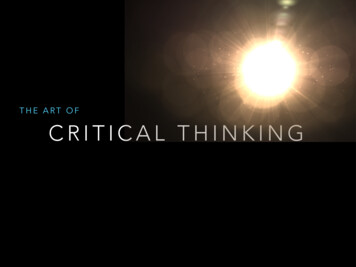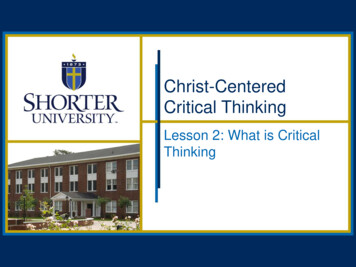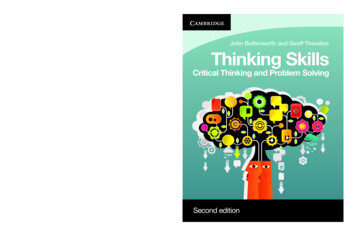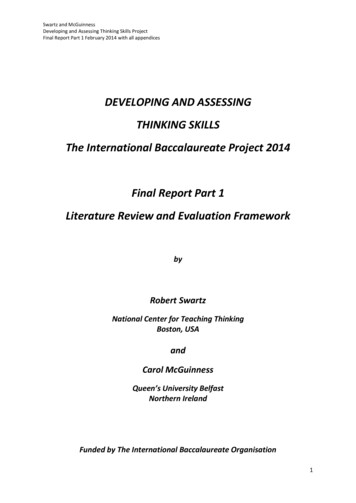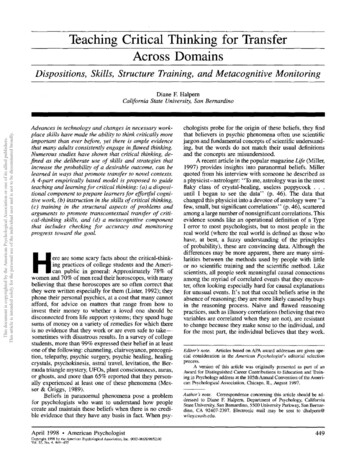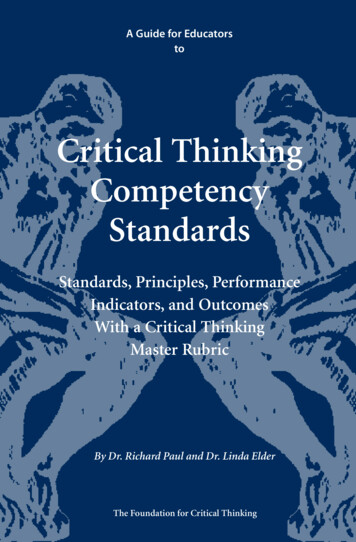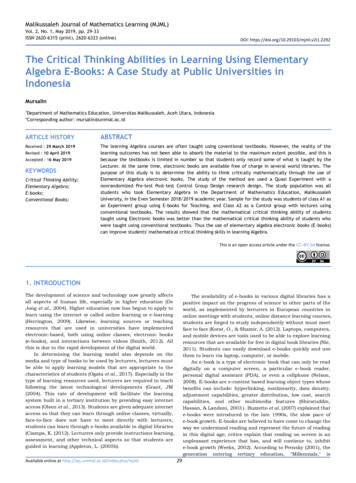
Transcription
Malikussaleh Journal of Mathematics Learning (MJML)Vol. 2, No. 1, May 2019, pp. 29-33ISSN 2620-6315 (print), 2620-6323 (online)DOI: https://doi.org/10.29103/mjml.v2i1.2292The Critical Thinking Abilities in Learning Using ElementaryAlgebra E-Books: A Case Study at Public Universities inIndonesiaMursalin1Department of Mathematics Education, Universitas Malikussaleh, Aceh Utara, Indonesia*Corresponding author: mursalin@unimal.ac.idARTICLE HISTORYABSTRACTReceived : 29 March 2019The learning Algebra courses are often taught using coventional textbooks. However, the reality of thelearning outcomes has not been able to absorb the material to the maximum extent possible, and this isbecause the textbooks is limited in number so that students only record some of what is taught by theLecturer. At the same time, electronic books are available free of charge in several world libraries. Thepurpose of this study is to determine the ability to think critically mathematically through the use ofElementary Algebra electronic books. The study of the method are used a Quasi Experiment with anonrandomized Pre-test Post-test Control Group Design research design. The study population was allstudents who took Elementary Algebra in the Department of Mathematics Education, MalikussalehUniversity, in the Even Semester 2018/2019 academic year. Sample for the study was students of class A1 asan Experiment group using E-books for Teaching, and Class A2 as a Control group with lectures usingconventional textbooks. The results showed that the mathematical critical thinking ability of studentstaught using Electronic books was better than the mathematical critical thinking ability of students whowere taught using conventional textbooks. Thus the use of elementary algebra electronic books (E-books)can improve students' mathematical critical thinking skills in learning Algebra.Revised : 10 April 2019Accepted : 16 May 2019KEYWORDSCritical Thinking Ability;Elementary Algebra;E-books;Conventional Books;This is an open access article under the CC–BY-SA license.1. INTRODUCTIONThe development of science and technology now greatly affectsall aspects of human life, especially in higher education (DeJong et al., 2004). Higher education now has begun to apply tolearn using the internet or called online learning or e-learning(Herrington, 2009). Likewise, learning sources or teachingresources that are used in universities have implementedelectronic-based, both using online classes, electronic books(e-books), and interactions between videos (Smith, 2012). Allthis is due to the rapid development of the digital world.In determining the learning model also depends on themedia and type of books to be used by lecturers, lecturers mustbe able to apply learning models that are appropriate to thecharacteristics of students (Ogata et al., 2017). Especially in thetype of learning resources used, lecturers are required to teachfollowing the latest technological developments (Grant, JM(2004). This rate of development will facilitate the learningsystem built in a tertiary institution by providing easy internetaccess (Olsen et al., 2013). Students are given adequate internetaccess so that they can learn through online classes, virtually,face-to-face does not have to meet directly with lecturers,students can learn through e-books available in digital libraries(Ciampa, K. (2012). Lecturers only provide instructions learning,assessment, and other technical aspects so that students areguided in learning (Appleton, L. (2005b).Available online at http://ojs.unimal.ac.id/index.php/mjmlThe availability of e-books in various digital libraries has apositive impact on the progress of science in other parts of theworld, as implemented by lecturers in European countries inonline meetings with students, online distance learning courses,students are forged to study independently without must meetface to face (Korat, O., & Shamir, A. (2012). Laptops, computers,and mobile devices are tools used to be able to explore learningresources that are available for free in digital book libraries (Nie,2011). Students can easily download e-books quickly and usethem to learn via laptop, computer, or mobile.An e-book is a type of electronic book that can only be readdigitally on a computer screen, a particular e-book reader,personal digital assistant (PDA), or even a cellphone (Nelson,2008). E-books are e-content based learning object types whosebenefits can include: hyperlinking, nonlinearity, data density,adjustment capabilities, greater distribution, low cost, searchcapabilities, and other multimedia features (Shiratuddin,Hassan, & Landoni, 2003 ). Buzzetto et al. (2007) explained thate-books were introduced in the late 1990s, the slow pace ofe-book growth. E-books are believed to have come to change theway we understand reading and represent the future of readingin this digital age; critics explain that reading on screen is anunpleasant experience that has, and will continue to, inhibite-book growth (Weeks, 2002). According to Prensky (2001), thegeneration entering tertiary education, "Millennials," is29
MursalinMalikussaleh Journal of Mathematics Learning (MJML) Vol. 2, No. 1, May 2019, pp. 29-33material well. Therefore, researchers are interested in doing thisstudy further to find out the increase and differences in theability to think critically using algebra e-books andconventional books, the reason being that as far as existingliterature studies, there is no research that explains in detailthe issue.fascinated by new technology and considers it a natural part oftheir environment. This paper is the findings of students'reported experiences and perceptions of e-books at ahistorically Black university. In other words, e-books areconsumed on the screen rather than on paper, which provideseasy access to readers by using a laptop, computer, or mobile orcalled m-learning.According to Nelson (2018), campuses become the mostimportant market place in using e-books. The results of studyby Woody et al. (2010) showed that the experience of readinge-books is not equivalent to reading textbooks. Also, accordingto Moody's (2010) findings, the use of electronic books inclassrooms is a growing trend. Educators are interested inusing reading technology to support emerging young readers,especially those who are at risk for reading failure. Besides, theuse of e-books provides evidence of positive experience as asource of electronic information (Appleton, 2004a).The results of study by Kissinger (2013) providesconclusions in using e-books (1) students express competencein the use of their mobile e-books, (2) students showed a feelingof high self-efficacy when using cellular e-books, (3) studentsvalue their use mobile e-books for their learning, (4) studentsindividually and metacognitive in their learning with mobilee-books, (5) students enhance their learning socially and inexisting learning opportunities, and (6) students and students.Instructors have different views about the value and usefulnessof interactive social textbooks. Besides, using e-books cansupport understanding (Zucker et al., 2009). Viewed from theability to read, the use of e-books can also improve children'sliteracy skills comprehensively (Grimshaw et al., 2007). Thusthe use of learning resources from e-books can make it easierfor students to learn and understand the materialindependently, especially in learning mathematics.Algebra is one of the subjects taught in higher education,especially in the Department of Mathematics Education.Algebra textbooks are very often found in digital libraries on theinternet, both provided free and commercially. Textbooksavailable in digital libraries are versions of books in PDF formator often referred to as one of the e-books. According to Yager etal. (2011), teaching using e-books can improve studentsperformance. For this reason, researchers are interested inusing E-books in teaching Elementary Algebra for Students ofthe Department of Mathematics Education, at MalikussalehUniversity, Indonesia.Malikussaleh University is one of the public universitiesthat runs the Department of Mathematics Education, under theFaculty of Teachers Training and Education, where thedepartment is still limited to books in the e-book version.Researchers believe that using this e-book will provide adifferent experience than using conventional textbooks. TheElementary Algebra e-book used by researchers is a bookwritten by Jerome E. Kaufmann and Karen L. Schwitters, 9EEdition, with the title Elementary Algebra published in 2009.The use of E-books on the Elementary Algebra subject is atransformation of learning in universities; at least it can build anew tradition for more dynamic learning resources. LikeBlended Learning (Garrison, D. R., & Kanuka, H, 2004). The useof ICT in teaching mathematics will also have a significantimpact on students' experience, at least using e-books in everysubject (Porter et al., 2014).The critical thinking skills seen in this study after learningby using e-books are the abilities of students who are built orformed in the learning process by using e-books. Students whohave this ability will be able to understand and analyze the2. RESEARCH METHODThis type of research used in this research is quantitativeresearch with quasi-experimental methods. Learning is dividedinto two types, namely learning using elementary algebrae-books and learning using conventional books. This study usesa Nonrandomized Pretest Posttest Control Group Designresearch design.Table 1. Design Research design t-testX1X1X-X2X2The study population was all students who took ElementaryAlgebra in the Department of Mathematics Education,Malikussaleh University, in the Even Semester 2018/2019academic year. While the sample for the study was students ofclass A1 as an Experiment group using Electronic Teachingbooks, and Class A2 as a Control group with lectures usingconventional physical textbooks. This research was conductedin February - March 2019.The test instrument used in this study is a test item tomeasure the ability to think critically mathematically, whichconsists of 4 items of essays given in the form of pretest andpost-test. The ability to think critically mathematically will bemeasured in the form of the ability to identify problems, takesteps to solve, clarify a statement, and make conclusions. Thiscritical thinking ability has been tested by Martiana (2015) inher unique study in learning mathematics.The data analysis technique used in this study uses anon-parametric test that is the Mann-Whitney test assisted bySPSS 18 Software program.3. RESULTS AND DISCUSSIONThe data used to calculate the increase in students'mathematical critical thinking skills is the N-gain value data.ResultsThe following is a table that illustrates the pretest, posttest, andnormalized gain (N-gain) descriptive data for tests ofmathematical critical thinking ability.Based on table 2, it can be seen that the difference in theaverage value of the pretest of the experimental class is greaterthan the average value of the control class pretest, this showsthat the score of students' mathematical critical thinking abilityapplied using the Problem Solving method is more varied andspreads on the class average. The data used to calculate theincrease in students' mathematical critical thinking skills is then-gain value data.Based on Figure 1, the N-gain value of the experimentalclass is 0.83, while that of the control class is 0.76. The resultsof this study indicate that the use of Algebra ElementaryE-books shows an increase in students' mathematical criticalthinking skills.30
MursalinMalikussaleh Journal of Mathematics Learning (MJML) Vol. 2, No. 1, May 2019, pp. 29-33Table 2. Score of the Mathematical Critical Thinking 300,830,18280,760,27ScoreAbilitiesCritical thinking%0,380,64Maximum Score 12DiscussionThe results showed that the mathematical critical thinkingability of the experimental class was higher than themathematical critical thinking ability of students in the controlclass. This shows that students in the experimental class havehigher mathematical critical thinking skills compared to thecontrol class.The ability to think critically in learning in the experimentalclass has increased. This can be seen from the answers ofstudents in analyzing the case problems given to them throughlearning using the Algebra Elementary E-book. Students aretaught using digital learning resources, where students canlearn independently by using their computer screens, laptops,and mobile wherever and whenever. Besides, students are givenmathematical assignments through the e-book.By using Algebra Elementary E-books in small groups,students are guided through analyzing existing problems withtheir thinking skills. It is expected that with the increasedability to think critically, students can use to analyze the issuesthat occur in the surrounding environment. This shows thatstudents in the experimental class have higher mathematicalcritical thinking skills than the control class.Based on the findings in the Algebra Elementary subjectlearning, the use of E-books on the subject is a transformationin college, and this can build a new tradition for learningresources that are more dynamic, independent and inexpensive.Like Blended Learning, ICT, and other multimedia, e-booksbecome one of the learning resources that are easily obtaineddigitally (Garrison, D. R., & Kanuka, H, 2004). The use of ICT inteaching mathematics will also have a significant impact onstudents' experience, at least using e-books in each subject(Porter et al., 2014).The critical thinking skills seen in this study after learningby using e-books are the abilities of students who are built orformed in the learning process by using e-books. Students whohave this ability will be able to understand and analyze thematerial well. Therefore, the results of data analysis can be seenthat the value of Sig. α 0.05, so H0 is rejected. That is, thereis an increase in mathematical critical thinking skills that aretaught using the Elementary Algebra E-book, and better thanthe mathematical critical thinking skills of students who aretaught by using conventional textbooks significantly.Mathematical critical thinking skills of students can also beseen from the average value obtained during the learningprocess. In the experimental class, the average values of N-gainobtained by students are 0.83, while in the control class, theaverage values of N-gain obtained by students are 0.76. Thisfinding can be interpreted that the use of E-books in lectures onthe subject Elementary Algebra in the Department ofMathematics Education, Malikussaleh University, Indonesiareceived excellent responses from students and improved theability to think critically mathematically. This is in line with theresults of research by Yager et al., (2011) that teaching usinge-books can improve student performance. Besides, usingFigure 1. N-Gain Score of Mathematical Critical ThinkingAbilityThe normality test aims to test whether the data obtainedhas a normal distribution or not. The n-gain score normalitytest in this study uses the Shapiro-Wilk technique where the sigvalue. (p-value) α (α 0.05), then H0 is rejected and if thevalue of sig. (p-value) α (α 0.05), then H0 is accepted.Table 3. Normality Test Results Data for N-gain of the CriticalThinking Experiment0,784300,001Rejected H0Control0,866280,072Rejected HaBased on the Table 3 above, it can be seen that the N-gainscore of the mathematical critical thinking ability of theexperimental class students has a Sig. α 0.05 so H0 isrejected. This shows that the N-gain score data of mathematicalcritical thinking ability of experimental class students are notnormally distributed, while the N-gain score of mathematicalcritical thinking ability of control class students has a Sig. α 0.05, so Ha is rejected. This shows that the N-gain score data ofmathematical critical thinking ability of control class studentsare normally distributed.Based on the results obtained from the normality test ofstudents' mathematical critical thinking abilities, one class ofn-gain values is not normally distributed then it is continuedwith the non-parametric test, namely the Mann-Whitney test.Table 4. Data of Non-Parametric Test ResultStatisticsValueConclusionMann-Whitney U235,000Rejected H0Asymp. Sig. (2-tailed)0.009Based on Table 4, it can be seen that the value of Sig. α 0.05, so H0 is rejected. That is, there is an increase inmathematical critical thinking skills that are taught using theElementary Algebra E-book, and better than the mathematicalcritical thinking skills of students who are taught by usingconventional textbooks significantly.31
MursalinMalikussaleh Journal of Mathematics Learning (MJML) Vol. 2, No. 1, May 2019, pp. 29-33Kissinger, J. S. (2013). The social & mobile learning experiencesof students using mobile E-books. Journal of AsynchronousLearning Networks, 17(1), 155-170.e-books can support understanding (Zucker et al., 2009).Viewed from the ability to read, the use of e-books can alsoimprove children's literacy skills comprehensively (Grimshaw etal., 2007). Thus the purpose of learning resources from e-bookscan make it easier for students to learn to understand thematerial independently, especially in learning 11365.pdfKorat, O., & Shamir, A. (2012). Direct and indirect teaching:Using e-books for supporting vocabulary, word reading, andstory comprehension for young children. Journal ofEducational Computing Research, 46(2), 135-152. DOI:https://doi.org/10.2190/EC.46.2.b4. CONCLUSIONBased on the results of study conducted it can be concludedthat there is an increase in mathematical critical thinking skillstaught by using Elementary Algebra E-book, and better thanthe mathematical critical thinking abilities of students who aretaught by using conventional textbooks significantly, or in otherwords that students 'mathematical critical thinking skills usingAlgebra Elementary E-books are higher than students'mathematical critical thinking abilities that are givenconventional textbooks. Thus the use of learning resources frome-books can make it easier for students to learn to understandthe material independently, especially in learning mathematics.Moody, A. K. (2010). Using electronic books in the classroom toenhance emergent literacy skills in young children. Journalof Literacy and Technology, 11(4), oliteracy.perkinsdev1.org/files/uploaded-files/JLT V11 4 2 Moody.pdfNelson, M. R. (2008). E-books in higher education: nearing theend of the era of hype?. Educause Review, 43(2), ibrary/2008/1/erb0801-pdf.pdfNie, M., Armellini, A., Witthaus, G., & Barklamb, K. (2011). Howdo e-book readers enhance learning opportunities fordistance work-based learners?. Research in LearningTechnology, 19(1), 19-38.REFERENCESAppleton, L. (2005b). Using electronic textbooks: promoting,placing and embedding. The Electronic Library. DOI:https://doi.org/10.1108/02640470510582736DOI: https://doi.org/10.1080/09687769.2010.548506Ogata, H., Oi, M., Mohri, K., Okubo, F., Shimada, A., Yamada, M.,& Hirokawa, S. (2017). Learning analytics for e-book-basededucational big data in higher education. In Smart Sensorsat the IoT Frontier (pp. 327-350). Springer, Cham. DOI:https://doi.org/10.1007/978-3-319-55345-0 13Appleton, L. (2004a). The use of electronic books in midwiferyeducation: the student perspective. Health Information g/10.1111/j.1471-1842.2004.00509.xOlofsson, A. D., & Lindberg, J. O. (2011). Informed design ofeducational technologies in higher education: Enhancedlearning and teaching. Simulation, 379.Buzzetto-More, N., Guy, R., & Elobaid, M. (2007). Reading in adigital age: e-books are students ready for this learningobject?. Interdisciplinary Journal of E-Learning andLearning Objects, 3(1), lo.org/Volume3/IJKLOv3p239-250Buzzetto.pdfOlsen, A. N., Kleivset, B., & Langseth, H. (2013). E-book readersin higher education: Student reading preferences and otherdata from surveys at the University of Agder. Sage Open,3(2), DOI: https://doi.org/10.1177/2158244013486493Ciampa, K. (2012). Reading in the digital age: Using electronicbooks as a teaching tool for beginning readers. CanadianJournal of Learning and Technology, 38(2), n2. DOI:https://doi.org/10.21432/T2NK5NPorter, W. W., Graham, C. R., Spring, K. A., & Welch, K. R.(2014). Blended learning in higher education: Institutionaladoption and implementation. Computers & Education, 75,185-195.De Jong, M. T., & Bus, A. G. (2004). The efficacy of electronicbooks in fostering kindergarten children's emergent storyunderstanding. Reading Research Quarterly, 39(4),378-393. DOI: https://doi.org/10.1598/RRQ.39.4.2DOI: ky, M. (2001). Digital natives, digital immigrants. On theHorizon, 9(5), 1-5.Garrison, D. R., & Kanuka, H. (2004). Blended learning:Uncovering its transformative potential in highereducation. The internet and higher education, 7(2), 95-105.DOI: fGrant, J. M. (2004). Are electronic books effective in teachingyoung children reading and comprehension?. InternationalJournal of Instructional Media, 31(3), 303-309.Shirattudin, N., Hassan, S., & Landoni, M. (2003). A usabilitystudy for promoting eContent in higher education.Educational Technology& Society, 6(4), 112-124.Grimshaw, S., Dungworth, N., McKnight, C., & Morris, A. (2007).Electronic books: Children’s reading and comprehension.British Journal of Educational Technology, 38(4), loadsexceeded.htmlSmith, M., & Kukulska-Hulme, A. (2012). Building mobilelearning capacity in higher education: E-books and iPads.Weeks, L. (2002, July 6). Ebooks not exactly flying off the shelves:Most readers stick to paper despite technology’s hype. TheWashington Post.Herrington, J., Herrington, A., Mantei, J., Olney, I. W., & Ferry,B. (2009). New technologies, new pedagogies: Mobilelearning in higher education.Wilson, R. (2003). Ebook readers in higher education. EducationTechnology and Society, 6(4), 8-17.DOI: w.edu.au/edupapers/91/32
MursalinMalikussaleh Journal of Mathematics Learning (MJML) Vol. 2, No. 1, May 2019, pp. 29-33Woody, W. D., Daniel, D. B., & Baker, C. A. (2010). E-books ortextbooks: Students prefer textbooks. Computers &Education, 55(3), 945-948.DOI: , S. E., & Szabo, Z. (2011, May). Using an e-Book to teachtechnology: Effects on student performance. In Proceedingsof the 49th SIGMIS annual conference on Computerpersonnel research (pp. 6-10).DOI: https://doi.org/10.1145/1982143.1982146Zucker, T. A., Moody, A. K., & McKenna, M. C. (2009). The effectsof electronic books on pre-kindergarten-to-grade 5 students'literacy and language outcomes: A research synthesis.Journal Of Educational Computing Research, 40(1), 47-87.https://eric.ed.gov/?id EJ84294433
The Critical Thinking Abilities in Learning Using Elementary . resources that are available for free in digital book libraries (Nie, 2011). Students can easily download e-books quickly and use . use of e-books provides evidence of positive experience



